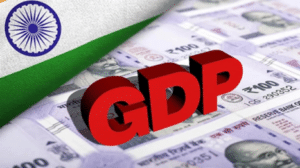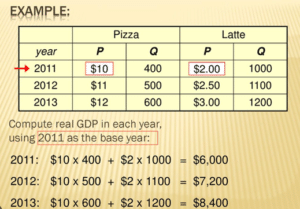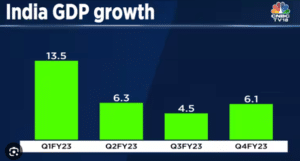A to Z of GDP.
To begin with, a revision of the base year of the national accounts statistics is needed.
Relevance
- GS Paper 3 Indian Economy and issues relating to planning, mobilization, of resources, growth, development, and employment.
- Inclusive growth and issues arising from it.
- Tags: #GDP #NSO #baseyear #statistics #currentaffairs #upsc.
Why in the News?
In the dynamic landscape of economics, accurate measurement of a nation’s Gross Domestic Product (GDP) is pivotal. India, as one of the world’s largest economies, has ambitious aspirations for its economic growth, yet achieving these goals requires precise data and a solid foundation. Central to this endeavor is the revision of the base year for national accounts statistics, a process that has been delayed for various reasons, including the COVID-19 pandemic. This article explores the significance of base year revision and its impact on India’s economic prospects.
Revision of Base Year: A Necessity
- To embark on the journey towards economic growth and development, it is crucial to begin with the immediate revision of the base year for national accounts statistics.
Current GDP Status: Aiming High
- Currently, India ranks as the world’s fifth-largest economy, but Prime Minister Narendra Modi has set an ambitious target to make it a $5-trillion economy by 2025.
- Despite the challenges posed by the COVID-19 pandemic, estimates suggest that India is on track to become the world’s third-largest economy by around 2027.
Leadership’s Vision
- In a bold assertion during the inauguration of Bharat Mandapam, Prime Minister Modi envisioned India as the third-largest economy during his third term. This is an ambitious endeavor, but it hinges on capturing economic growth accurately.
Ministry’s Responsibility: A Critical Role
- The Ministry of Statistics and Programme Implementation holds the primary responsibility for GDP measurement and must develop robust systems to achieve this. The question is: Is the Ministry prepared for this monumental task?
Base Year Revision Delay: A Growing Concern
- A pivotal task in ensuring accurate GDP measurement is the immediate revision of the base year.
- Unfortunately, this process has been significantly delayed due to various reasons, including the ongoing pandemic. Presently, India’s GDP is computed with a base year of 2011-12, which is over a decade old.
- Ideally, base year revisions should have occurred in 2016-17, with preparations for another revision in 2021-22.
Importance of Base Year Revision: Adapting to Change
- Using an outdated base year fails to capture the evolving economic landscape. A revised base year is essential to account for new activities stimulated by both government initiatives and private sector endeavors.
Data Gap Challenges: Critical Surveys and Databases
- However, challenges persist. The Ministry of Statistics and Programme Implementation has not yet released crucial survey results, including the consumer expenditure survey and the annual survey on unincorporated enterprises.
- Additionally, the examination of other available databases, particularly those stemming from GST and digital payments, must commence immediately.
Impact of Infrastructure Investments: A Changing Economic Landscape
- Over the past decade, the government has made significant investments in infrastructure. This has led to increased production capacity and foreign investment, contributing to value addition through diversification, efficient technologies, and enhanced capacity.
Complexity of GDP Compilation: A Multifaceted Endeavor
- GDP compilation is a complex exercise, and revising the base year adds another layer of intricacy. This process requires a thorough assessment of existing data sources and the exploration of new data sources that have emerged over time.
Using New Data Sources: A Prudent Approach
- Utilizing new data sources necessitates caution, aligning with global guidelines provided in the System of National Accounts 2008.
- Given the time required for this task, the Ministry of Statistics and Programme Implementation, along with the National Statistical Commission, should initiate the process expeditiously.
Validation with Supply Use Tables: Ensuring Transparency
- To enhance GDP compilation, efforts should be made to introduce Supply Use Tables, critical for validating national accounts statistics. With India gaining substantial experience in preparing these tables, validation should occur before the release of GDP estimates, addressing any discrepancies in data interpretation.
Accurate measurement of GDP is essential for India’s economic aspirations. A critical step toward achieving this accuracy lies in revising the base year for national accounts statistics. While challenges such as data gaps and complexities in GDP compilation persist, they can be overcome with proactive measures and adherence to global standards. As India continues its journey toward becoming a global economic powerhouse, a robust foundation of accurate economic data will be indispensable.
|
Gross Domestic Product Gross Domestic Product, commonly known as GDP, quantifies the aggregate worth of all end-stage products and services generated within the territorial boundaries of a nation during a defined timeframe. GDP serves as a key metric for gauging a country’s economic performance and its overall well-being. Formula For Calculating GDP GDP = C + I + G + IX where, C = Consumption (Expenditure by households on goods and services) I = Investment (Spending by businesses on capital goods like machinery, buildings, and technology) G = Government Expenditure (Expenditure by the government on public services and infrastructure) IX = Export – Import (The difference between exports and imports) Calculating GDP · India calculates its GDP using two distinct methodologies, which yield similar but not identical results. The first method is based on economic activity at factor cost, while the second is based on expenditure at market prices. These methods lead to the computation of nominal GDP (using current market prices) and real GDP (adjusted for inflation). Among these figures, GDP at factor cost is the most commonly observed and reported. Types of Gross Domestic Product 1. Real GDP · Real GDP represents the total value of all goods and services produced by an economy in a specific year, expressed in prices from a chosen base year which is 2011 for India. It is also referred to as constant-price GDP or inflation-corrected GDP. 2. Nominal GDP · Nominal GDP measures a country’s economic output while considering current market prices. Unlike real GDP, it does not account for inflation or changes in price levels, which can potentially overstate the growth rate. All products and services in nominal GDP are valued at the prices at which they were sold during the reporting year. 3. GDP Per Capita · GDP per capita is a metric that quantifies the GDP on a per-person basis within a country’s population. It provides insights into the average productivity or living standards in an economy. There are three variations of GDP per capita: nominal, real (inflation-adjusted), and purchasing power parity (PPP) GDP per capita. 4. GDP Purchasing Power Parity (PPP) · Although not a direct GDP measure, purchasing power parity (PPP) is used by economists to compare one country’s GDP to others in “international dollars.” This comparison adjusts for differences in local prices and the cost of living, enabling cross-country assessments of real output, income, and living standards. Base effect · The base effect refers to the impact of a prior period’s numerical base, typically used for comparison in economic and statistical analysis. When evaluating economic indicators like GDP, inflation rates, or other metrics, the base year serves as a reference point for measuring changes. · Any significant fluctuations or deviations from this base year can be attributed to various factors, including economic conditions, policy changes, or external events. · The base effect is particularly important when assessing year-on-year changes, as it helps distinguish between short-term fluctuations and sustainable trends. · Analysts use the base effect to provide context and determine the magnitude and direction of changes in economic data. |
Sources: Indian Express
Mains Question
“What is the significance of revising the base year for national accounts statistics in the context of India’s economic growth goals?” 250words.






